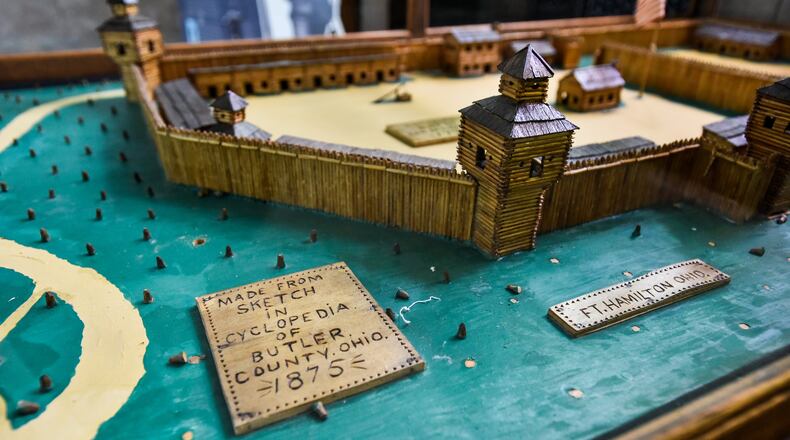Tony Rucci, president and CEO of the America 250 Foundation and a retired Ohio State University professor, says he already wakes up sweating at 2 a.m. some nights thinking about what’s to come.
Organizers estimate that in 1976, there were 50,000 local events, Rucci said.
The Bicentennial lasted more than 1976 itself, and included an address given Dec. 31, 1975, by then-President Gerald Ford, and tall-masted sailing ships from many nations visiting New York Harbor on July 4 and Boston Harbor several days later. More than 100 countries celebrated with the U.S. that year.
“Wow,” Hamilton Mayor Pat Moeller said recently when asked about that upcoming anniversary. “I never even thought about that. Wow.”
The city of Hamilton in 2016 celebrated the 225th anniversary of the completion in 1791 of Fort Hamilton, a supply depot used in wars against Native Americans, and some at that time snickered at a 225-year celebration.
When Moeller was asked whether he considered the nation’s 200th or 250th birthday to be a bigger deal, he said: “My view would be this: Some countries don’t last even a few years before there’s radical change in who’s running the country. We will have 250 years of a solid foundation, and then following that solid foundation, for 250 years. That is so super-significant.”
Rucci said his group hopes 100,000 communities host events, and there should be about 347 million people living in the country.
“How do you touch 347 million people in a way that causes it to resonate for them personally, at an individual level?” said Rucci, who grew up in Youngstown. “(The 250th anniversary) needs to be more personal than 200 was.”
A non-partisan commission is working on events that will begin in mid-2025. Events might include a train or flat-bed truck visiting 250 smaller U.S. cities, gathering with each town’s mayor and flocks of students to show off artifacts or documents from the National Archives or Smithsonian to middle-school students.
“Are we going to do things like the tall ships again? Probably,” Rucci said. “And we’ve been very explicit that our charter includes international-country involvement.”
The Ohio area in 1776
So what was the area now known as Ohio like on the first Independence Day, July 4, 1776?
About 22 tribes had links to the area. Also, “there were some white settlers that were mainly squatters in the Ohio region,” said Cliff Eckle, a history curator at the Ohio History Connection, formerly known as the Ohio Historical Society. Among the tribes were Shawnee, Wyandot, Delaware, Tuscarora, Potawatomi, Miami, Seneca-Cayuga and Ottawa. Ohio itself takes its name from the Seneca word meaning “good river.”
In 1776, the British had a strong base in Detroit. But in 1763, with the end of the French and Indian War, England’s King George III set a “Proclamation Line” that forbade settlement west of the Appalachan Mountains. He set that line because England had many debts and couldn’t afford to fight more wars.
“So to keep the Indians on the frontier quiet, they pevented the settlers on the East Coast from coming into that territory,” Eckle said. Most Indians living in the Ohio lands likely saw the British as “the lesser of two evils” compared to the American colonists, because the British only wanted trading partners, as opposed to colonists, who wanted to settle the land with farms and towns, “disrupting the Indian way of life,” Eckle said.
For indigenous people, “It was a very popular place to live,” said John Low, an associate professor in the department of Comparative Studies at Ohio State University-Newark. It had a good climate, great resources and waterways, “which were the highways back then,” Low said.
During the Beaver Wars of the late 1600s, the Iroquois people had driven many others out of the area in a fight over beaver pelts, because beaver had been hunted almost to extinction in the original colonies. The decades afterward were “a period of time of people coming back home and filling the area back in,” said Low, a citizen of the Pokagon Band of Potawatomi.
“But it also was a difficult time, in that diseases were running rampant throughout Indian nations.” Diseases from Europeans killed 80-90 percent of some tribes, even before they had encountered many settlers, he said.
“There was also conflict in that colonial settlers in Kentucky, the Kentuckians, were pretty notable for their disdain for Indian people, and their intention of moving throughout Ohio, and so they regularly crossed the Ohio River Valley,” Low said. The French and British had already built forts in the region, and were competing for beaver trade and alliances with Indian tribes, so they were fighting with each other.
“It was a complicated and difficult time for Indian people, no doubt about that,” Low said. “Change was in the air, and there were tribes already migrating west, to avoid the settlers, to avoid diseases the settlers brought.”
The only Revolutionary War fort, in what now is Ohio, established in about 1778, was at Fort Laurens, located north of what now is Dover, Ohio. Americans used that fort for attacks on the British.
For fans of history wanting to take road trips, Eckle recommends three places in the Dover, Ohio, area: Schoenbrunn Village, a recreation of a town established by Delaware Indians who converted to Christianity; Fort Laurens (it’s no longer standing, but was a place were 21 were killed, and it features the Grave of the Unknown Patriot of the American Revolution); and nearby Zoar Village, which was founded by about 200 German Separatists in 1817. The village includes many original buildings.
About the Author
